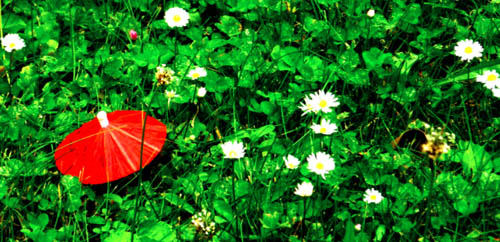- Article publié sur le site GETIROSHIMA.COM

I plant my hands in the small garden:
I will grow green.
I know, I know, I know.
And the birds
will lay eggs
in the grooves
of my inky fingers. -- Forough Farokhzad
Shirin Neshat
Born and raised in Iran, Shirin Neshat, winner this year of the 6th Hiroshima Art Prize, was studying art in the
U.S. when, in 1979, strict Islamic rule took hold of her country.
|
Upon returning, eleven years later, she addressed
herself to her homeland with a striking series of photographs of Islamic women, entitled Women of Allah. The
series was an attempt to make sense of her own estrangement, to ask questions of it. Many of the women wear
traditional dress and hold guns. This might seem too obvious a juxtaposition, particularly with an artist based in
New York, looking at Islamic Iran to some ext
ent from the outside (is the gun external threat? is it Islamic
militancy? is it authority or the subversion of authority? is it the harbinger of modernity or the guarantor of
tradition? is it male? is it sexless? the
questions proliferate), yet the result is an unsettling harmony,
so that it is less a juxtaposition than a synthesis.
|
|
These women look very much at home in their clothes, with
their children, with their guns, with verses from the Koran and other literature painted on their hands, their
faces, their shawls. Women with presence.
In the late 90s Neshat began to work with film and in 1998 produced the stunning split-screen Turbulent where male
and female singers face each other across the black void of the exhibition space. The man performs a classic song
(based on a 13th century poem) to a sedately appreciative audience. The woman waits. She, in turn, delivers an
empassioned, inchoate vocal outpouring to a concert hall devoid of audience. As with the photographs, a simple
idea is realised with subtlety and despite the distance and separation of man and woman, men and women, their
common humanity is the overriding impression. Neshat believes, though, that the participation of men in their
reactionary society fixes them more firmly in the chains of convention, whereas women, oppressed and marginalised,
achieve a greater freedom of the spirit, thus the man sings a classic song in a conventional way and the woman
improvises in a wild and implicitly rebellious manner. A lesser artist might have chosen a stilted performance for
the man, devoid of emotional impact, yet Neshat does the opposite. The man sings with enormous emotional power, but
the woman's passion is hauntingly empty.
|
Rapture (1999) extends and elaborates on this theme. Men on one screen gather in purposeful communion in a
coastal fortification while women, on the other, move away in bare array, one group pushing out forlornly to sea in
a wooden vessel.
In 2001 Neshat collaborated with Philip Glass on Passage, an atmospheric depiction of a burial, this time on
one screen, but maintaining a powerful separation of the sexes, the men transporting the body across landscapes
while the women scoop out the ground with their bare hands, preparing the burial site.
There are a total of six films (all ten to thirteen minutes long, on continuous loop) to see in the present
exhibition which runs until October 16th at the Hiroshima City Museum of Contemporary Art.

|

|





































